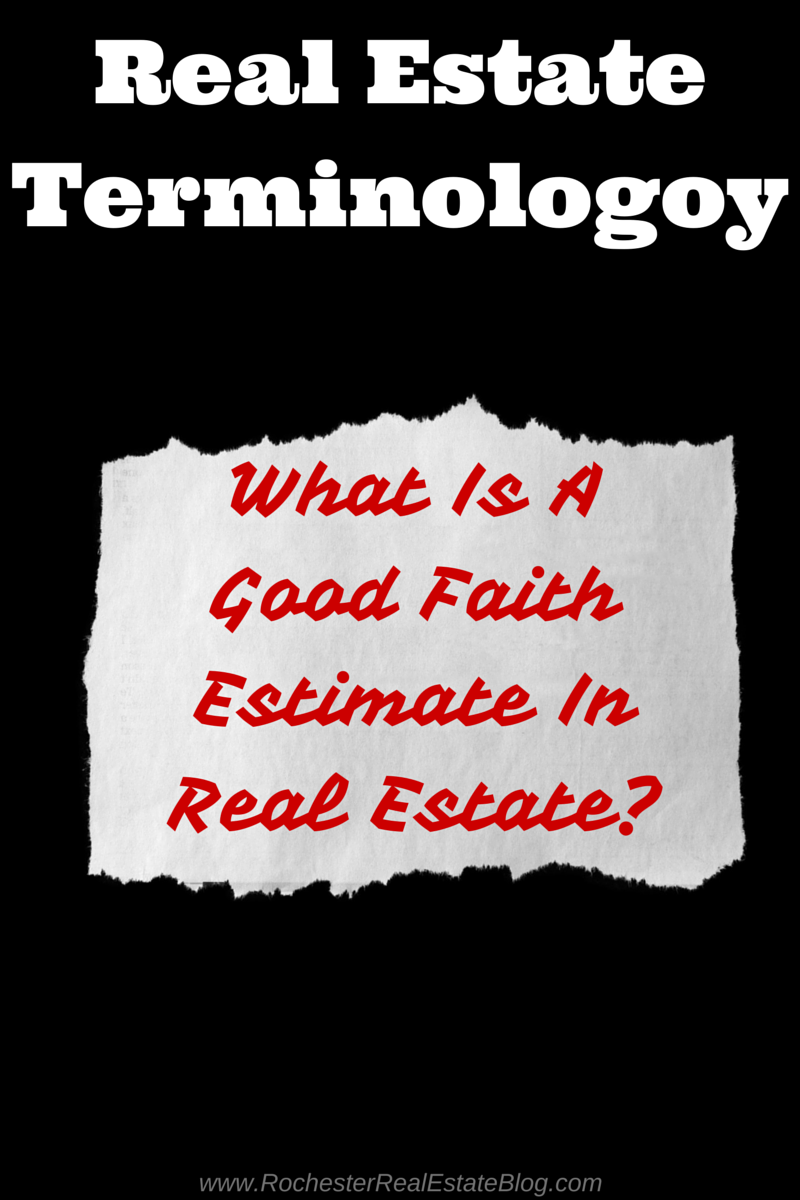What Is A Good Faith Estimate In Real Estate?
Have questions about buying or selling a home?
Ask Now!
What Is A Good Faith Estimate In Real Estate?
The Good Faith Estimate, or GFE, is an extremely important document for potential homebuyers. Required by law to be provided within 3 days of your mortgage application, it is an estimate of the potential closing costs associated with a loan from a particular lender. Obtaining a GFE is free but you could incur a small credit report fee if one is needed.
The costs that appear on it are only an estimate in good faith and therefore may be subject to change. We strongly recommend that you take the time to understand how to read a GFE and acquire one from a few different lenders when you are in the market for a home loan.
GFEs are Required by Law
In 1974, the United States Congress passed the Real Estate Settlement Procedures Act to stymie the flow of unsavory real estate practices that were running rampant at the time. The intention was to help push the real estate settlement costs down and encourage competition between lenders and related services.
The latest RESPA rule went into place in 2010. It required and standardized the use of Good Faith Estimates. It became one document that all lenders had to use and required it be provided (or mailed) within 3 days of receiving a loan application. It also mandated that lenders stand by the issued GFE for 10 days, giving potential homebuyers a tool and the time necessary to compare rates from different lenders.
Understanding the Good Faith Estimate
The very first thing that one should understand about a Good Faith Estimate is that it is not a binding contract. Neither party, you or the lender, is obligated to go through with the loan just because you have received one. So instead remember that as a means to increase industry competition, it is a great tool to use at the negotiating table.
It is perhaps a potential home buyer’s tool to get the best closing costs they can. It is only common sense that a home buyer would want to understand how to read one.
As for the layout, it is a simple 1-3 page document (the HUD-1 Settlement Statement includes the final GFE, is a standard 3-page document, and is provided at closing). It has a summary, including important dates, general loan information, and escrow information. There is also a more detail breakdown of the settlement costs associated with the loan. This section is most important for comparison and negotiations. The third section outlines which charges can increase and by how much and contains both a trade-off table and shopping cart, which are basically standardized comparison tools.
Luckily, Good Faith Estimates are designed with the consumer in mind. You should become familiar with the different types of costs you will see listed on your GFEs. From there, you can develop an understanding of which of the costs might change and why. You see, some of the costs are static. Others are in your hands, the hands of your lender, or in the hands of a third-party.
But as far as homeowners are concerned, all the different costs ultimately fall into three categories. Some cannot change after the GFE (0% tolerance); some can change by up to 10 percent (10% tolerance); others have no limits placed on how much they may change (no tolerance). Let’s sort these out now.
0% Tolerance Costs
This group of costs includes fees that the individual lenders charge. One of these lender fees is the origination charge, which is made up of processing and underwriting fees, appraisal fee, credit report, and loan discount points. In addition, once your interest rate is locked, the credit or charge corresponding to that lender’s rate and the adjusted origination charge are set in stone as well. If in fact these charges are higher at the time of signing, it is the lender’s responsibility to cover them.
10% Tolerance Costs
The total of this group is allowed to increase by 10% total, so that means that individual elements may increase or decrease by more. What counts here is the total. This group of charges is mostly made up of 3rd party charges which the lender selects or recommends. Going with their suggestions is the only way to get this sort of protection, though if you go with your own 3rd party source for these services, you should be in good enough communication with them to have a good idea what kind of rate you will see at signing. This grouping is made up of title services, title insurance charges, and government recording charges.

Use A Good Faith Estimate To Your Advantage
No Tolerance Costs
The last category of costs you will find on your Good Faith Estimate is the group that can change with no restrictions. This includes charges for any lender required service for which you select a 3rd party outside of the list provided by the lender. But what you will find listed in the GFE is your initial escrow deposit, your daily interest charges, and your homeowner’s insurance charges.
Our advice is to shop around on the services you can shop around for. While the lender is required to give you suggestions, their listed are usually limited in length. If you want to be sure that you are getting competitive rates for these services, shop around outside of the lender’s suggested providers. At the very least, you need context to ensure the providers they recommend offer quality service at a respectable rate.
Using the GFE to Your Advantage
The main thing a Good Faith Estimate allows you to do is compare rates between lenders and negotiate those rates down. Because lenders must provide one within 3 days (as long as you are not denied) and honor it for a 10 day window, it gives you a chance to get multiple GFEs and examine them side by side.
There are though, a few important things to remember when using GFEs to compare lenders. Be sure that any copy you use for a serious comparison was issued after your interest rate is locked in. Because some changes are directly dependent on that locked-in rate, it is important that you are working with the official estimate.
Additional Good Faith Estimate Resources
- Good Faith Estimate Example via HUD
- The Basics of a GFE courtesy of Elizabeth Weintraub on about.com
- Closing Cost Calculator from HSH
Other Resources Relating To Mortgages & Buying Real Estate
- What Are Seller Concessions in Real Estate via Rochester’s Real Estate Blog
- Home Financing & Mortgages – The Top Articles & Resources via Storify
- Top 10 Mortgage Mistakes To Avoid via Maximum Real Estate Exposure
- How Much House Can I Afford? via Frederick Real Estate Online
- Is A Final Walk Through Necessary? via The Las Vegas Luxury Home Pro
- 20 Cold, Hard, Facts in Real Estate Home Buying via Imagine Your House
Today’s article, “What Is A Good Faith Estimate In Real Estate,” was written by Anita Clark, a top Warner Robins, GA Realtor. Anita is a full-time Realtor who aids both home buyers and home sellers with all of their real estate questions. Follow Anita on Google+ and also be sure to check out her real estate blog at www.sellingwarnerrobins.com.
If you’re a buying a home in Rochester, NY, you need to know what a good faith estimate is and what the purpose of it is. A top mortgage consultant will explain what a good faith estimate is, but if they don’t, this article is a great resource for understanding what a good faith estimate is in real estate. Contact me and I can recommend several top Rochester, NY mortgage consultants for you to discuss your financing needs with.
About the authors: The above article “What Is A Good Faith Estimate In Real Estate” was provided by the Keith Hiscock Sold Team (Keith & Kyle Hiscock). With over 30 years combined experience, if you’re thinking of selling or buying, we’d love to share our knowledge and expertise.
We service the following Greater Rochester NY areas: Irondequoit, Webster, Penfield, Pittsford, Fairport, Brighton, Greece, Gates, Hilton, Brockport, Mendon, Henrietta, Perinton, Churchville, Scottsville, East Rochester, Rush, Honeoye Falls, Chili, and Victor NY.
Visit our website at www.HiscockHomes.com.